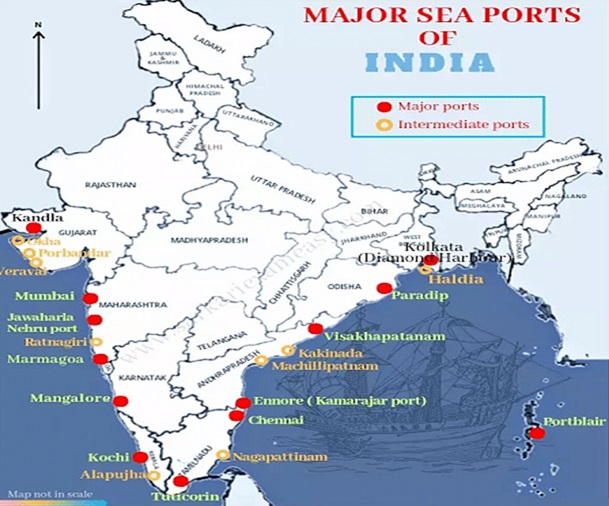
India’s port sector is a vital pillar of the country’s economic infrastructure. With a coastline stretching over 7,517 kilometres, India is strategically positioned as a major maritime nation. The maritime sector handles about 95% of India’s total trade by volume and 70% by value, making it crucial for foreign trade, industrial growth, and regional development.
Classification of Ports in India
Major Ports in India
- India has 12 operational major ports, with Vadhavan and Galathea proposed as the 13th and 14th.
- These are administered directly by the Ministry of Ports, Shipping, and Waterways (MoPSW).
- Managed under the Major Port Authorities Act, 2021, they operate on the "Landlord Port Model", where the government owns the port infrastructure, and private players handle terminal operations.
- Key Major Ports:
- Mumbai Port: Largest natural port in India.
- Kolkata Port (Shyama Prasad Mukherjee Port): The oldest major port and the only riverine port in India.
- Ennore Port (Kamarajar Port): Located in Tamil Nadu, it is India's only corporatized port registered as a company.
Minor Ports in India
- Over 200 non-major (minor) ports, governed by respective state governments under the Indian Ports Act, 1908.
- Regulated by State Maritime Boards or respective state departments.
- Developed largely through Public-Private Partnerships (PPP) models via concession agreements.
Key Government Initiatives for Port Sector in India
Sagarmala Programme (2015)
- Objective: To reduce logistics costs, enhance port-led industrialization, and improve cargo movement.
- Focus Areas:
- Port modernization
- Connectivity enhancement
- Port-led industrial clusters
- Coastal community development
- Over 800 projects identified worth more than ₹5.5 lakh crore.
Maritime Amrit Kaal Vision 2047
- Long-term vision to transform India into a global maritime power by 2047.
- Focuses on:
- Quadrupling port handling capacity
- Promoting inland water transport and coastal shipping
- Achieving green and sustainable maritime growth
National Logistics Portal (Marine)
- A unified digital platform connecting various logistics stakeholders.
- Enhances efficiency, reduces costs and delays, and promotes transparency in port operations.
Sagar Manthan
- A real-time digital dashboard for monitoring port performance.
SAGAR-SETU App
- A mobile application offering real-time updates on vessel movement, cargo status, finances, and regulatory compliance — enhancing the Ease of Doing Business.
Performance and Global Ranking in Logistics Performance Index
- India ranks 22nd in the World Bank’s Logistics Performance Index (2023) under the “International Shipments” category.
- Average Turnaround Time (TAT) for ships in Indian ports is 0.9 days, better than many global peers in South Asia.
Private Sector Participation
- India promotes private investments in port infrastructure, especially through PPP models in both major and non-major ports.
- Examples: Mundra Port, Pipavav, Dhamra Port — all developed and operated by private companies like Adani Ports.
- PPP Models Include:
- BOT (Build-Operate-Transfer)
- BOO (Build-Own-Operate)
- Assets are returned to the Port Authority after the concession period.
Key Challenges in the Port Sector
- Capacity constraints at many older major ports.
- Inadequate last-mile connectivity to road and rail networks.
- High logistics costs compared to global benchmarks.
- Regulatory overlaps between center and states.
- Need for greater digitization and green energy transition.
Future Outlook
- India aims to become a global maritime hub by:
- Expanding capacity through new ports like Vadhavan & Galathea.
- Accelerating digitization and automation.
- Promoting green ports with clean energy, electric cargo handling, and shore power.
- Integrating inland waterways and coastal shipping under the PM GatiShakti Master Plan.
- Creating port-based SEZs and industrial corridors.
Frequently asked questions in the exam.
Q. How many major ports are there in India?
India has 12 major ports, and two more (Vadhavan and Galathea Bay) have been proposed, which will bring the total to 14.
Q. Who administers major and non-major ports in India?
Major ports: Administered by the Central Government under the Ministry of Ports, Shipping & Waterways.
Non-major ports: Regulated by State Governments.
Q. Which is the oldest major port in India?
Kolkata Port (now Shyama Prasad Mukherjee Port) is the oldest and the only riverine major port in India.
Q. Which is the largest natural port in India?
The Mumbai Port is the largest natural harbour in India.



